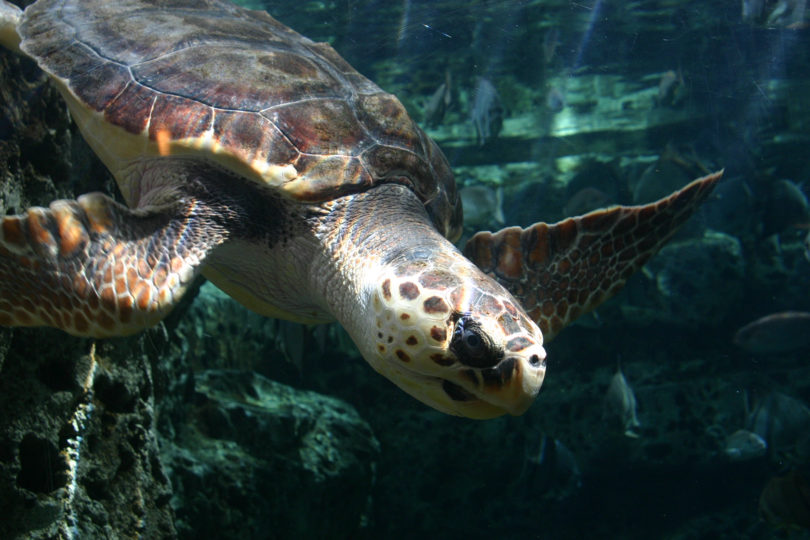Athens, Ga. – Sea turtle researchers in the University of Georgia’s Warnell School of Forestry and Natural Resources are using new technologies to unlock the mysteries of the ancient mariners: genetic fingerprinting.
By creating a database of DNA taken from turtle eggshells, the UGA team is leading research that could be vital to the conservation of the endangered animals.
Since they started this DNA project nearly a decade ago, Warnell researchers have used what they call “CSI for turtles” to identify 7,573 sea turtle mothers in over 34,500 nests. They’ve honed their genetic tagging technique into a fine art, and in the 2015 “State of the World’s Sea Turtles” report, they discuss the benefits of using DNA to track maternal turtle lineage over traditional tagging methods.
The innovative genetic fingerprinting techniques developed by Brian Shamblin, an assistant research scientist, and Joe Nairn, a Warnell professor, is a key feature in the 2015 “State of the World’s Sea Turtles” report, produced through a partnership consisting of the Oceanic Society, IUCN Marine Turtle Specialist Group, Duke University’s OBIS-SEAMAP and a number of international organizations, scientists and conservationists.
“Thanks to collaboration with the great beach monitoring network who collect samples, we are producing demographic data on a scale that would be impossible with conventional tagging,” Shamblin said. “Understanding marine turtle behavior requires combining several different approaches, and genetic tagging is another technique that we’ve added to the toolbox.”
The “SWOT” team, short for State of the World’s Sea Turtles, focuses on creating a network of specialists around the world who are focused on the conservation of sea turtles and their habitats. The “SWOT Report” has been published every year since 2006 and features new findings and innovations in the efforts to conserve sea turtles. Nairn and Shamblin’s work is featured because their method of using DNA to track turtle mothers allows them to collect data that researchers simply cannot get through traditional approaches.
Nairn’s team focuses on loggerhead sea turtles, one of seven species of the reptile. Put on the endangered species list in the 1970s, loggerheads are found in the Atlantic, Pacific and Indian oceans and are some of the largest and most visually striking turtles in the world. Once hunted for their meat and eggs, loggerheads have also historically been prone to being unintentionally entangled in fishing nets. Combined with naturally high mortality rates for small juveniles, this caused the turtle’s populations to decrease significantly worldwide. Nest numbers fluctuate from year to year, but Georgia had an average year in 2014 with about 1,200 nests, Nairn said, so turtle biologists are hoping to see a lot of the turtles return for a big year in 2015.
“Many people don’t know that the southeastern United States is one of only two large loggerhead rookeries in the world,” Nairn said. “The population here is absolutely critical to global conservation for the species, particularly as the other one is Oman in the Arabian Sea.”
Nairn and Shamblin developed the Northern Recovery Unit Loggerhead DNA Project, and they have received a total of $2.5 million since 2008 through various funding opportunities to study the threatened sea turtles.
The way their method works is like this: During the “nest validation” period, researchers collect a single egg from each nest they find from Georgia to Maryland. Nairn and Shamblin use the shell to get the mother’s DNA, and then the yolks are used by other researchers to study where turtles are foraging in between nesting seasons. Taking a single egg from the nest, Nairn said, does not affect the turtle’s overall population numbers.
Traditional methods call for researchers to attach a tag to turtle flippers to track them, but studies show that flipper tagging can miss up to 20 percent of all females that nest on a beach each season. Researchers also know that females nest on several different beaches, which can cause miscalculations about the turtle population. They can’t monitor all of the beaches where the turtles nest at night, and many of the flipper tags get lost eventually, Nairn said. But much like a human fingerprint, the genetic signature obtained using the DNA method is unique for each individual turtle.
Not only does this DNA information identify the turtle mother, but it also allows researchers to speculate on population recovery, including how many nests are being laid, how often turtles nest and how many females are laying eggs. Over the first two years of the study, UGA identified around 800 nesting mothers along the Georgia coast, and researchers continue to track those turtles, including where they’ve nested over the years and how often they’ve returned to nest.
“Thanks to dozens of Georgia volunteers, technicians and collaborators with Georgia Department of Natural Resources, we are able to continue the project,” Nairn said. “Loggerhead turtles are a long-lived species and take 25 or 30 years to reach reproductive age, so our goal is to genotype nesting females for several more years. This will allow us to address unanswered questions about remigration intervals as well as recruitment and mortality in this unique population.”
For more information about the SWOT team and the state of the world’s sea turtles, visit the group’s website at www.seaturtlestatus.org/.





